Cotton can overcome many environmental stresses and produce profitable lint yields when the crop gets off to a good, uniform start. The question becomes, when is the “best” time to plant cotton to ensure good establishment? Cotton production in Kansas is typically thermally limited, with slower warming in soil temperatures and higher surface residue levels than in other cotton-growing areas. Because of our relatively thermally-limited environment, cotton in Kansas must be planted as early as possible to maximize yield potential. However, those extra heat units from early planting are only beneficial if an adequate stand is made. For many reasons, including seedling chilling, potential herbicide injury, thrips damage, and seedling diseases, it pays to plant when growers can get an adequate stand and when the crop will grow vigorously.
Like corn, the goal is to achieve an adequate and uniform stand, both in terms of space between plants as well as plant age. The recommended planting window for cotton in Kansas is relatively narrow compared to other summer crops, roughly May 1 through June 5. However, it is best to make planting decisions based on soil conditions rather than calendar dates. Soil temperature trends can be monitored using the Kansas Mesonet (http://mesonet.k-state.edu/agriculture/soiltemp/). The Mesonet can provide a general idea of soil temperatures and trends across the state. However, producers must monitor conditions at the field level, considering differences in residue, soil moisture, and other factors that can result in warmer or cooler temperatures than those observed at the local Mesonet station. Cotton seed germination and early growth/emergence are favored by soil temperatures above 64°F and adequate, but not excessive, soil moisture. Based on USDA-ARS research work at Lubbock, TX, seedling cotton requires more than 100 hours above 64°F at the seed level to emerge.
Soil Temperatures – Current, Departure from Normal, and Forecast
We often use 60°F at planting depth in Kansas as our baseline temperature. As of April 13, the statewide average 7-day 4-inch soil temperature is 57.3°F or 2.3°F above normal. As is often the case this time of year, there have been large swings in air temperature. Highs in the 90s in southwest Kansas on April 12 were followed by lows in the 20s on the 15th. This has led to daily average soil temperature fluctuations, but the 7-day averages are still running slightly above normal. The 8 to 14-day outlook favors above normal temperatures to close out the month of April. The average date on which the statewide 7-day average soil temperature first reaches and remains over 60°F is May 6, but this threshold should be reached earlier than normal this year, given the warmer-than-normal forecast..
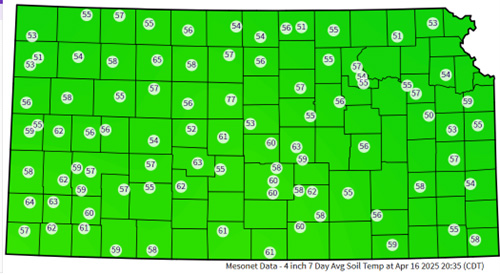
Figure 1. Average 7-day 4-inch soil temperatures (°F) as of April 16, 2025. Data and image courtesy of Kansas Mesonet (mesonet.k-state.edu).
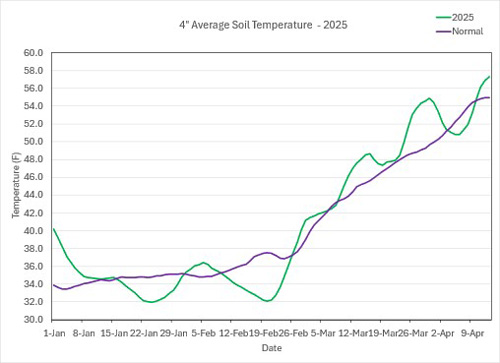
Figure 2. 30-Year average (1991-2020), and 2025 average 4-inch soil temperatures. Average data plotted are 7-day values. Dates plotted represent the midpoint of the 7-day average period (e.g., plotted data for April 13 are the 7-day averages for the period April 10-16. Graph created by Matthew SIttel, K-State Research and Extension.
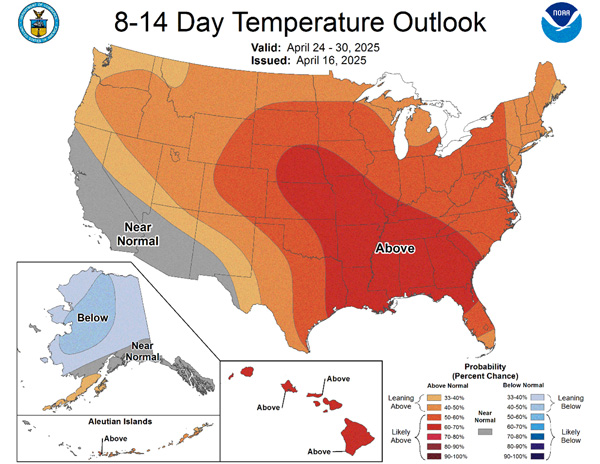
Figure 3. The Climate Prediction Center’s 8 to 14-day temperature outlook for the period April 24-30, 2024. Source: NOAA Climate Prediction Center.
Information from North Carolina State University’s cotton web page illustrating the importance of heat unit accumulation immediately following planting is shown in Table 1.
Table 1. Relationship between predicted DD-60s and Planting Conditions (Source: North Carolina State University, https://cotton.ces.ncsu.edu/)
|
Predicted DD-60 accumulation for five days following planting |
Planting conditions |
|
10 or less |
Very Poor |
|
11 – 15 |
Marginal |
|
16 – 25 |
Adequate |
|
26 – 35 |
Good |
|
36 – 49 |
Very Good |
|
50 |
Excellent |
|
Avoid planting cotton if the low temperature is predicted to be below 50°F for either of the two nights following planting or predicted daily DD-60s is near zero for the day of planting. |
|
Effects of cold soil on cotton seeds
Cotton seed exposed to cold for the first 2-3 days after planting, OR when the seed is absorbing moisture from the soil, is susceptible to chilling injury. The greatest sensitivity is during the first day after planting when the seed is taking up water, as shown in Figure 4. In the first 30 minutes after planting, the seed will absorb up to 60% of the water necessary for germination.
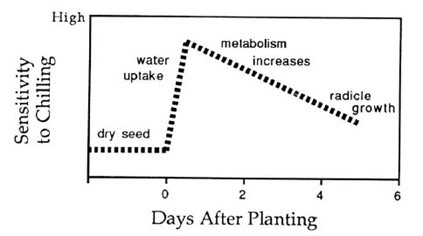
Figure 4. Relative sensitivity of cotton to chilling in the first several days after planting. K. Hake, W. McCarty, N. Hopper, and G. Jividen.
Seedlings may suffer damage if soil temperatures drop below 50°F during this critical germination period. Damage may result in malformed seedlings, loss of or damage to the taproot, and a greater likelihood of seedling disease problems. Injury usually kills the root tip, stopping normal taproot growth and leading to lateral root development (Figure 5). If the plants survive, the root system will not develop normally. Very cold soil temperatures (<45°F ) will likely lead to seedling death.
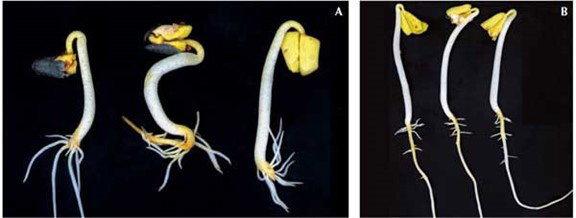
Figure 5. Seedlings in A and B were exposed to the same temperature (86°F) with the exception of the first six hours of imbibition in which seedlings in A were exposed to chilling temperatures of 40°F. Photos by N. Hopper, Texas Tech University and J. Burke, USDA-ARS, Lubbock, TX.
Seed Quality – Warm and Cold Germination Scores
In addition to adequate soil temperature, it is imperative that producers in Kansas plant cotton seed with exceptional seed quality and understand both their warm and cold germination scores on their seed lots. Warm germination scores are standardized across the industry and are legally required on seed tags. Cold germination tests are not required by law but are available from reputable seed companies. Be cautioned that cold germination test procedures are not necessarily uniform across companies. Be sure to ask and understand what methodology was used before comparing cold germination scores across companies.
Generally, the cold germination test for cotton should be conducted at 64.4 degrees, with that temperature held constant for seven days. To be counted as germinated, the seed must sprout, and the radicles of the sprouted seed must reach at least 4 cm in length. However, the results for the cold germination test are not nearly as repeatable as those of the warm test, which is the primary reason why there is no legal standard such as for warm germination. Producers should plan to plant cotton seeds with the highest cold germination scores first. Cold scores greater than 85% are generally preferred for early planting. Some companies may be able to provide the Cool-Warm Vigor Index score for their seed. This test, developed in Texas, gives a score that is the combined percentage of the 4-day warm germination test and the cool germination test. Scores <120 = Poor, 120 to 139 = Fair, 140 to 159 = Good, >160 = Excellent. Producers should first plant seeds with the highest scores and move to lower-scoring seed lots as soil temperatures increase.
Logan Simon, Southwest Area Agronomist – Garden City
lsimon@ksu.edu
Lucas Haag, Northwest Area Agronomist
lhaag@ksu.edu
Matthew Sittel, Assistant State Climatologist
msittel@ksu.edu